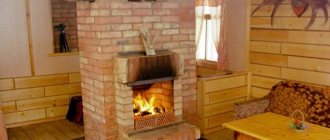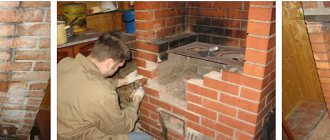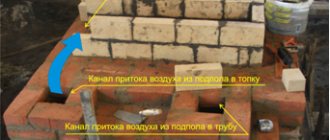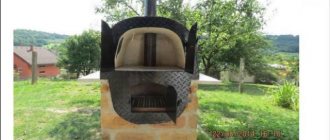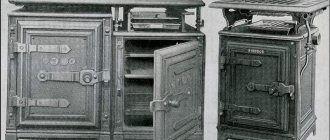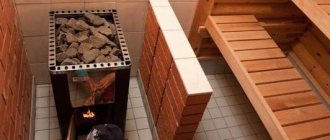The designs of modern stoves are constantly being improved, changed, and supplemented. However, there are elements whose functions are difficult to do without. As an example, you can install grates for the oven (grid).
The grate is a part of the combustion chamber that supports logs, coal, and fuel briquettes. Through the cracks in it, the ash falls down, freeing up space for a fresh portion of fuel. There are different design solutions for these elements; they are made from different materials. From the article you will learn how to choose and how to properly place the grate in the oven.
Cast iron grate for oven flat
Why is it needed?
As has already become clear, the grate is a grate that allows the air flow to penetrate directly to the combustion center below, and the ash to be removed through the holes to a specially designated place for it. So why do we need grates in a furnace? Installing a grate in a furnace allows you to solve a number of problems:
- Divides the combustion chamber into two zones - the combustion chamber itself and a niche for ash.
- Used for placing and drying fuel.
- Distributes the air flow from the ash pan.
- Promotes good traction.
- Together with the door it makes it possible to control and regulate the flame.
The grate, which is intended for installation in the stove, cannot be made from any metal. Since it is constantly exposed to high temperatures and oxygen, it can begin to oxidize very quickly. Only cast iron can survive in this environment for a long time
Conclusion
When choosing a high-quality grate, you should take into account the design features of the stove. The choice of a specific design and lattice components depends on the nature of the fuel. A grate for a sauna stove made of cast iron will last longer than the same one made of steel or other metals.
The weight of the fuel itself is also of great importance. Installing gratings does not require special knowledge. You can correctly place the grates in the oven yourself; it is enough to take into account only a few nuances. With the right choice of material and installation, they will last you a very long time.
Design features and types
The grate is a grate with separate elements that perform the function of maintaining fuel in the combustion chamber. Based on the design, it is customary to distinguish the following types:
- Flat tile grate. This grate for the furnace is the most common. It is also used in boilers and fireplaces. Its difference lies in certain dimensions. This nuance must be taken into account when laying the stove manually. An installation platform is required for installation into a heating device. It should be easy to remove and the gap should be at least 50mm. After all, almost all grates are made of cast iron, and when expanded, it can cause harm to the combustion chamber and ash pan.
- Beam lattice. This cast iron grate for the stove is stackable. The number of elements must correspond to the dimensions of the firebox. The beam option is the best for arranging a non-standard handmade stove. However, it is necessary to remember about the standards for its length.
Beam grate for oven
- Basket-shaped. Such grates can be used in open fireboxes. Recently, they are installed quite rarely, because a heating device of this type has lost its relevance.
Basket-shaped grate
- Movable grid. The main function in this case is to limit the size of the gap between the grates through the shift of the moving part in the horizontal plane. This is quite convenient for the automatic operation of long-burning stoves.
Movable grate design
Which stove grate to choose and how to install it yourself
The designs of modern stoves are constantly being improved, changed, and supplemented. However, there are elements whose functions are difficult to do without. As an example, you can install grates for the oven (grid).
The grate is a part of the combustion chamber that supports logs, coal, and fuel briquettes. Through the cracks in it, the ash falls down, freeing up space for a fresh portion of fuel. There are different design solutions for these elements; they are made from different materials. From the article you will learn how to choose and how to properly place the grate in the oven.
Cast iron grate for oven flat
Why is it needed?
As has already become clear, the grate is a grate that allows the air flow to penetrate directly to the combustion center below, and the ash to be removed through the holes to a specially designated place for it. So why do we need grates in a furnace? Installing a grate in a furnace allows you to solve a number of problems:
- Divides the combustion chamber into two zones - the combustion chamber itself and a niche for ash.
- Used for placing and drying fuel.
- Distributes the air flow from the ash pan.
- Promotes good traction.
- Together with the door it makes it possible to control and regulate the flame.
The grate, which is intended for installation in the stove, cannot be made from any metal. Since it is constantly exposed to high temperatures and oxygen, it can begin to oxidize very quickly. Only cast iron can survive in this environment for a long time
The grate is a grate with separate elements that perform the function of maintaining fuel in the combustion chamber. Based on the design, it is customary to distinguish the following types:
- Flat tile grate. This grate for the furnace is the most common. It is also used in boilers and fireplaces. Its difference lies in certain dimensions. This nuance must be taken into account when laying the stove manually. An installation platform is required for installation into a heating device. It should be easy to remove and the gap should be at least 50mm. After all, almost all grates are made of cast iron, and when expanded, it can cause harm to the combustion chamber and ash pan.
- Beam lattice. This cast iron grate for the stove is stackable. The number of elements must correspond to the dimensions of the firebox. The beam option is the best for arranging a non-standard handmade stove. However, it is necessary to remember about the standards for its length.
Beam grate for oven
- Basket-shaped. Such grates can be used in open fireboxes. Recently, they are installed quite rarely, because a heating device of this type has lost its relevance.
Basket-shaped grate
- Movable grid. The main function in this case is to limit the size of the gap between the grates through the shift of the moving part in the horizontal plane. This is quite convenient for the automatic operation of long-burning stoves.
Movable grate design
The dimensions of cast iron grates for a furnace depend on the type of fuel. Their possible sizes are presented in the table.
FirewoodCoal
| 330*252 mm | 350*205 mm |
| 300*252 mm | 300*205 mm |
| 250*252 mm | |
| 250*180 mm | |
| 140*180 mm | |
| 120*140 mm |
If it is necessary to install beam gratings, you need to remember that the length is 250, 330 and 470 mm.
When choosing a specific model, you should take into account the type of fuel that you plan to use. Take note of the size chart above. The grate must be taken in such a way that the rods can easily support the maximum possible weight of one fuel portion. This information can be clarified with a store consultant or specialist.
We suggest you read: Contraindications for visiting baths and saunas: who should not go to the steam room
To clear ash, it is better that the gaps occupy at least 40% of the area of the entire structure.
note
If there are fewer of them, the combustion chamber will not function as efficiently, because the volume of incoming air will be small for good combustion. If ventilation is poor, gases may accumulate.
In the case of large gaps, fuel that has not had time to burn out will fall into the gaps along with the ash.
Now let’s figure out how to properly put the grates into the oven manually.
It is known that materials are susceptible to expansion when heated, which is why grates need to be installed with a gap of at least five millimeters on all sides. In the firebox it is necessary to cut off a ledge. The grille is installed with edges. In a brick stove, the location is determined one brick below the combustion door. This is necessary to prevent hot coals from falling onto the floor.
During installation, it is not recommended to close the grates too much. Different materials, when heated, expand with different forces, and very strong fixation of the device can cause deformation or lead to cracking of the masonry. After laying the grating, the grooves are tightly filled with sand without cement.
As you can see, the grate has its own role in the oven.
Cast iron is the best material from which such a stove element can be made, as it is characterized by durability and reliability.
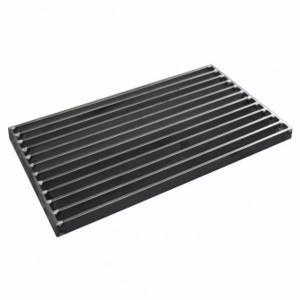
When choosing a grate, it is worth remembering the type of fuel, its weight, and the size of the gaps. Monolithic options are easy to install, and stacked ones are ideal for assembling gratings of unusual dimensions.
It is quite possible to make a grate with your own hands in a home workshop. What is a stove grate, how best to make and install it - we will try to talk about all this in the article below.
The grate for the stove is part of the support platform in the form of a grate for laying solid fuel in the combustion chamber of the stove.
The material from which grates for furnaces are made in the factory is cast iron and steel. Homemade structures are assembled from steel elements.
This important element of the furnace combustion chamber allows you to get the maximum effect from fuel combustion. The structure of modern stoves is constantly being modified and improved, and only the main structural element of the firebox remains unchanged. The combustion equipment retains its grate configuration.
The platform supports any type of solid fuel (firewood, coal and briquettes). Through the through openings, air is sucked in from below, which creates effective draft inside the combustion chamber.
Important
Combustion products (ash) fall into the ash pan (ash pan), freeing up space for the top layer of fuel.
The grate promotes uniform combustion of fuel, thereby achieving maximum thermal energy transfer from the fuel placed in the combustion chamber.
Types of grate
Increasingly, various fireplaces and stoves are being installed in country houses, which, despite their differences, have one common element. This element is the grate for the furnace. It can be of different shapes, differ in size, material, but its functions in all stoves and fireplaces remain unchanged.
The design features of a modern stove are constantly being modified and improved, new elements are replacing old ones. But a number of functional details remain unchanged attributes and it is simply unrealistic to do without them. These include grates for ovens.
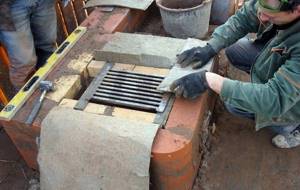
This combustion element of a potbelly stove or fireplace, supporting firewood, coal and fuel briquettes, provides good traction. Through the holes, ash falls down, which makes room for a new fuel load.
Cast iron grates of modern stoves can have different designs and are made of various materials, including metal corners.
Thanks to the grate, wet fuel in a fireplace or stove dries out faster.
The DIY design of this element affects the efficiency of the furnace, and the materials used for manufacturing determine the service life.
Correctly installing the grate will ensure the full performance of the assigned functions. Stove casting determines how high quality home heating will be.
For the manufacture of grate bars, various materials and various designs can be used. In most cases, heat-resistant steel or cast iron is used.
note
The fact is that the grates are constantly exposed to fire and therefore it is better to choose cast iron. since it has a high strength index. There are two types of grate:
The furnace firebox can have different sizes and shapes, so furnace casting manufacturers make all sorts of configurations. For a firebox with non-standard dimensions, you can also easily select a suitable model.
We suggest you familiarize yourself with: Construction of a water storage tank
Solid types include monolithic types without the possibility of disassembly. The choice of sizes is quite wide, so the main reference point is the firebox area. The basis of typesetting models is made up of several individual elements. This is something like a constructor.
which you can assemble with your own hands and get the desired grille size.

Steel grates for a type-setting stove have the form of a conveyor belt and are called chain grates, and models with the possibility of cooling and made from pipes with your own hands are called pipe grates.
Cast iron grates can be of several types:
- tiled. Rectangular models used for solid fuel boilers, fireplaces and heating stoves. They are universal, the main thing is to determine the standard size;
- basket Ideal for an open hearth. The main purpose is cooking, but today they are used extremely rarely, since the design is morally outdated;
- beam These models owe their name to their resemblance to construction beams. They have the appearance of a stacked structure and consist of double or single elements. The optimal solution if you need to assemble a grate of non-standard size;
- movable. Such gratings have a design feature. allowing you to change the width of the gaps, which is often not enough during installation. In most cases, they are used in long-burning furnaces.
Dimensions of grate for the furnace
The dimensions of cast iron grates for a furnace depend on the type of fuel. Their possible sizes are presented in the table.
| Firewood | Coal |
| 330*252 mm | 350*205 mm |
| 300*252 mm | 300*205 mm |
| 250*252 mm | |
| 250*180 mm | |
| 140*180 mm | |
| 120*140 mm |
If it is necessary to install beam gratings, you need to remember that the length is 250, 330 and 470 mm.
Recommendations for selection
When choosing a specific model, you should take into account the type of fuel that you plan to use. Take note of the size chart above. The grate must be taken in such a way that the rods can easily support the maximum possible weight of one fuel portion. This information can be clarified with a store consultant or specialist.
To clear ash, it is better that the gaps occupy at least 40% of the area of the entire structure. If there are fewer of them, the combustion chamber will not function as efficiently, because the volume of incoming air will be small for good combustion. If ventilation is poor, gases may accumulate. In the case of large gaps, fuel that has not had time to burn out will fall into the gaps along with the ash.
Installing a grate in a furnace
Now let’s figure out how to properly put the grates into the oven manually.
It is known that materials are susceptible to expansion when heated, which is why grates need to be installed with a gap of at least five millimeters on all sides. In the firebox it is necessary to cut off a ledge. The grille is installed with edges. In a brick stove, the location is determined one brick below the combustion door. This is necessary to prevent hot coals from falling onto the floor.
During installation, it is not recommended to close the grates too much. Different materials, when heated, expand with different forces, and very strong fixation of the device can cause deformation or lead to cracking of the masonry. After laying the grating, the grooves are tightly filled with sand without cement.
A frequently asked question is which side should the grate be placed in the oven if the cross-section of the rods is in the shape of a triangle. The answer is triangles down.
As you can see, the grate has its own role in the oven.
We put the grate
In general, it would be good to establish the cause of the grate falling out and eliminate it. If the masonry is cracked and comes apart with the risk of coals getting into the house structure, then a clear relocation of this section of the furnace is required. Especially if the ceiling above the blower channel collapsed. But in general, you need to decide locally - it’s difficult to give advice on repairs in absentia.
So if it is not possible to shift this section of the hearth, then we place small pillars of brick in the corners of the ash pit. The approximate cross-section is 2x2 cm. We glue them with a solution of the same composition as when repairing cracks - more on that below.
The figure schematically shows the location of the grate in the furnace body
On the right (according to the picture) you can place a brick plate to support the grate - moving the grate towards the furnace door of the stove will not harm. And the reduction in cross-section will be insignificant. They can be neglected.
On the left (following the figure), where there is a channel for air intake and ash removal, you will have to install two columns. We clean the masonry from ash and soot and glue it. For ordinary clay mortar. Just first moisten the surfaces with water.
Sometimes such an insert is replaced with a U-shaped metal stand. They simply place it under the grate, like miniature construction goats. The rule is the same: it stands freely, there is room for expansion.
Installing a grate in a furnace
The grate is installed when installing a stove and fireplace, but if it is necessary to repair or replace the grate in the unit, you must first understand the reasons for the damage to the grate, or its displacement, or fall. The seat for the grate must provide not only mechanical retention of the grate, but also thermal clearances to compensate for the linear expansion of the part. The size of 0.5 cm around the entire perimeter of the grate is minimal, but it will protect both the brickwork from damage due to expansion of the metal of the grate, and the grate itself from deformation when heated. Brick and metal have too different coefficients of linear thermal expansion, and compensation clearance is required. The brick frame - a row under the grate - is cut together to form a corner. This simplifies the installation of the grate, and if necessary, disassembly and replacement of the grate. Cleaning the grates is also simplified.
Ways to solve the problem
If the grate is damaged, there are two options: fill the ash chamber with a brick or install a new grate.
The option of filling is acceptable only if the integrity is damaged or there are cracks and it is impossible to eliminate them at the base of the ash pit. At the same time, it would be good to replace the firebox door from a blank door to a door with a grille to regulate the flow of secondary air. But this option will definitely create a lot of unnecessary trouble and reduce the efficiency of the furnace. Therefore, we change the grate.
The grate is usually made of cast iron. Cast iron is very different from brick in terms of CTE - coefficient of thermal expansion. This indicator for iron is much higher than for ceramics. Therefore, the grate is always placed freely with a gap of 5-10 mm around the entire perimeter. Some manuals recommend filling the gaps between the masonry and the grate with sand. But this is very stupid advice. Unnecessary and even harmful. Firstly, the sand from the heat of the coals (and it can reach 1100 degrees Celsius) simply sinteres - vitrifies, tightly welding the grate to the masonry and depriving it of the necessary freedom. Secondly, after the first fire, this gap is filled with ash - a non-flammable and non-caking material. So why make unnecessary movements?
It is important to place the grate correctly - an inverted grate quickly becomes clogged with ash and stops working. Therefore, we remember that the grate slits expand downward, not upward. Sometimes the grate has a thickening in the middle - this is to equalize thermal stress, and not to roll the coals to the edges, as some people think.
The figure shows the correct (bottom) and incorrect (top) position of the grate
Peculiarities
The grate is made by hand as a single piece; most often, cast iron is used for its production. The grille of the structure has holes through which air is drawn to the fuel.

The part is laid in such a way that the grille holes are directed from the door opening to the rear wall. For large combustion chambers you will need several grates.
It is quite possible to make a grate with your own hands. It is an important element in the combustion chamber, thanks to which it is possible to obtain efficient combustion of fuel. The designs of modern furnaces and boilers are constantly changing, and details are being improved. But there is a functional element that you can’t do without. This element is the grate.
The grate serves to support wood, coal and fuel briquettes. Through its holes, ash pours down, thereby freeing up space for a new batch of firewood. Grate bars vary in design and are made from different materials.
Do-it-yourself brick oven repair
If your brick stove is broken and needs to be repaired, then in this article you will find practical tips for repairing stoves with your own hands and the specifics of their implementation.
You can and should repair the stove yourself using your own means.
There are different types of ovens. They usually consist of a foundation, pre-furnace sheet, firebox and ash pit
An ordinary brick stove consists of a foundation, a pre-furnace sheet, a firebox and an ash pan (in common parlance - a ash pan). A grate must be attached inside the stove. The outer part is the chimney and pipe. Often the stove is equipped with a cast iron stove. In some versions, the stoves are lined with tiles.
Let's look at the most common types of brick slab failures and options for eliminating them yourself. Repairs are divided into 3 types: current repairs, medium repairs and major repairs.
Current (minor) repairs
There is a special door for cleaning the oven.
The stove cannot be lit - there is no draft. Occurs for some reason. This, for example, after a long break in using the stove, accumulation of cold air in the chimney, lack of air flow that would support combustion, strong wind outside; chimney clogged with soot.
We do this: we use not paper for ignition, but a piece of rubber or dry fuel; Kerosene and other flammable liquids are not recommended.
If the chimney is clogged with soot, this can be determined by how long ago it was “burned out.” It is recommended to do this at least once a year, preferably in the summer. It is necessary to take a number of measures to eliminate this problem. First, you need to try to burn off the soot using a handy method. First, pour a handful of coarse salt into the burning stove and quickly close the damper, because it will crack a lot and pieces of soot will fly out through the chimney. If it doesn’t help, then you need to clean it manually through a door specially designed for this.
If the stove smokes a lot, the brickwork may have become leaky and as a result, cracks have formed that need to be covered by hand.
If the brickwork is “leaky,” then the seams are covered with a solution of clay and sand with the addition of crushed asbestos fiber and salt.
For smearing, prepare a solution of clay and sand with the addition of crushed asbestos fiber (for elasticity) and salt, 100 g per 3 liters of solution. The solution should be of medium viscosity (this is important, since a greasy solution will dry out and crack; a thin solution will not provide strength, and the masonry will then crumble). You can buy a baking mixture in the store and do everything according to the instructions that are included. Repairs with a ready-made mixture are faster.
The problem of replacing burnt-out bricks arises when the old one falls out or burns out.
We clean the place of the old brick from clay and dust with our hands, moisten it with water, and place a previously prepared clay cake there. Before laying the new brick, we dip it in water and coat the sides and top with clay mortar to secure all the seams. Next, carefully place it in place of the fallen or burnt brick. The mortar for brickwork is the same as for sealing cracks.
Medium renovation work
When replacing grates, it is necessary to provide a 5 mm expansion joint between the grates and the brickwork.
This is the repair and strengthening of furnace parts with your own hands.
You can strengthen a loose fire door by first dismantling the brickwork next to it and re-fastening the door using steel wire.
When replacing grates, you need to take into account that they should not lie close to the brickwork, but with a gap of 5 mm; fill the gap with sand.
Pre-furnace sheets should be replaced; if they are holed or rusted, they should not be repaired. They removed the old sheet, took out the nails, put a piece of felt soaked in a liquid clay solution underneath, and nailed a new sheet on top.
The stove must be periodically whitened with a lime solution. Lime is known for its antibacterial properties.
When replacing the lining, the old and new masonry are made of homogeneous brick, since there must be the same coefficient of thermal expansion.
A stove that has a broken firebox lining, a damaged chimney, or a need to re-lay the brick “under” needs more serious repairs. When changing the lining, you need to take into account the fact that the old and new masonry are made of homogeneous brick, since there must be the same coefficient of thermal expansion. The brick in the chimney is replaced in the same way.
Repair of a tiled stove deserves special attention. Very carefully, the damaged tile is removed, the place where it was was cleaned, it is placed on a mortar previously made from clay with the addition of crushed brick, and a new tile is placed, which is first adjusted to the size of the place. The masonry should be smooth, smooth out any unevenness by hand.
Major reconstruction
Major repairs of a brick stove include restoring full functionality, replacing or improving broken parts. You can also do this on your own.
When repairing a chimney, the damaged masonry is sorted out. The outside of the chimney can be plastered.
Chimney repair. On the outside we simply plaster the masonry. If the masonry is destroyed, you need to sort it out.
Lining. If you need to change it completely, it is not recommended to touch the main brickwork of the stove. We disassemble the furnace wall from the ash pan to the height of the firebox, do not touch the furnace ribs, remove the crushed stone from dismantling the old lining, lay out a new one without tying it with the brickwork of the walls. Seams should be no more than 2 mm thick.
What to make grates from
To make the grate in the furnace, fire-resistant steel and cast iron are used. Since the grate is constantly exposed to combustion, cast iron is considered the best option for its manufacture.
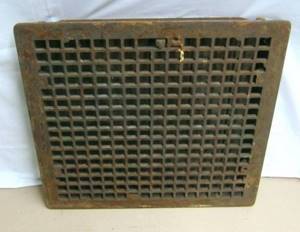
Even the strongest steel will become damaged over time due to exposure to constant fire. And the combustion temperature of coal is considered to be one of the highest among all types of fuel. It is for this reason that cast iron is chosen for the manufacture of the grate. When exposed to high temperatures, steel material has the ability to oxidize, and in the future it rusts and breaks down.
Grate design
The size of the grate depends on the fuel that will be used in the future. For everyday use, two designs are recommended - solid and composite.
The first option consists of a cast iron grate, which is selected according to the size of the combustion chamber. The second type is assembled from individual elements.
The size of a composite grate is determined in the same way as a solid one, based on the size of the firebox. In addition to differences in type, devices are also divided by functionality.
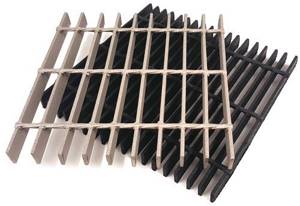
The design of the cast iron grate comes in two types: full-rotating and swinging. In the first case, the elements have the ability to rotate horizontally by 180 degrees, which allows you to dump ash and slag.
This design involves grooves in the combustion chamber for additional holes. It is extremely difficult to make a full-circle system at home.
Types of grate
The grate is made from elements of different shapes, but only from cast iron and steel. Other materials do not withstand frequent calcination or are too expensive. Depending on the design, grate bars are divided into several types:
- tile grating;
- beam grate
- basket;
- mobile grid.
Tile grate
One of the most common types of grate is the tiled grate. The main feature of this design is the observance of strictly fixed dimensions. This grille is designed for an installation site of a certain size. A mandatory condition must be met - the presence of a gap between the outer perimeter of the grate and the walls of the firebox of at least 5 mm. If this size is not maintained, the cast iron grate may expand greatly when heated and damage the firebox.
Beam grate
The grate consists of a set of individual grate elements. On opposite sides of the installation site, grooves are made into which cast iron bars are placed. Such a system is not entirely convenient for cleaning grates, and today these designs are practically not found. However, it should be noted that when using an antique stove, this is an acceptable option for installing a grate.
Basket
The basket is the same lattice, only with high sides. This type of grate was used in open fireboxes, but now such equipment is practically not used
Types of cast iron grate
Cast iron grate also comes in several types. The tile grate has a rectangular pattern installed in the opening of the boiler, stove or fireplace. This type is considered universal in use. The basket type grate is ideal for an open hearth that is intended for cooking.
This model is currently practically not used. A beam lattice consists of a single or double element, which in its design resembles a construction beam.
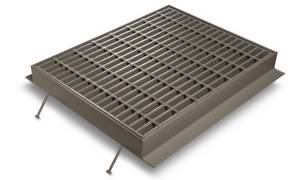
Beam cast iron grate is used for installation of non-standard structures. There is also a movable grille. It got its name due to the fact that its model is capable of changing the width of the gaps. The movable grille is most often used for long-term operation.
What types of grate designs are there?
If we talk about products made of heat-resistant steel, then there are pipe and chain varieties of grates.

As for cast iron grates, there are several types:
- Tiled . Such rectangular grates are widely used in solid fuel stoves and boilers, fireplaces. We can say that these are universal products. You just need to choose the right grate size.
- Baskets . This type of grate was used in open hearths where food was prepared. Currently, they are practically never found.
- Beam . Externally, such grates resemble beams for construction. They are single or double stacked parts from which you can build a grill of any size.
- Movable gratings . The peculiarity of this design is that the grille links can be moved in a horizontal plane, changing the clearance between them. As a rule, such grates are used for long-burning furnaces.
Making a grate at home
You can make a grate with your own hands only from steel, since it is almost impossible to make a structure from cast iron at home.
For work, it is better to choose fire-resistant steel, but this is not a prerequisite. It is necessary to take into account what type of fuel the grate will be made for; its size depends on this.
For coal, a design of 300x300 mm or 350x300 mm is suitable, and for burning wood, the size of the grate will be from 140x120 mm to 300x225 mm.
Using simple iron, it is necessary to plan the stages of work so that in the end the grate is thick enough. You can use steel strips and reinforcement. Before you start making a grate with your own hands, you need to take the dimensions in advance. The next stage is the production of the frame.
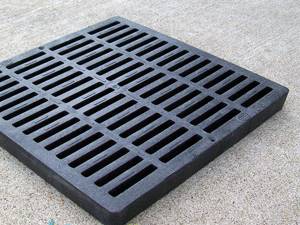
The frame is considered the basis when installing the grate; later, parallel elements are welded to it. It is important to choose the correct distance between elements in the frame. Here it is necessary to take into account that ash does not leak through the holes, and air can circulate freely to maintain combustion.
Holes in the grill should not occupy more than 40% of its area. Do not forget that compliance with safety regulations has not been canceled. It is worth taking care of clothes and shoes in advance, especially at the welding stage.
Dimensions
Another condition for choosing a grate for a stove is its length and width. The sizes of the grate for the furnace are different, they are determined by the type of fuel:
- For light firewood or briquettes, grates from 140x120 mm to 330x252 mm are sufficient.
- For coal, larger parameters are needed: 300x300, 350x300, since this fuel emits a large amount of harmful substances when burned.

Variety of grate sizes
Grill installation
Metal tends to expand at high temperatures, so the grate must be installed with a small gap of no more than 5 millimeters in each direction.
The ledge in the combustion hole needs to be cut off; the grate itself will be located on it in the future. In a brick stove, the location for the grate is generally chosen below the opening of the firebox door by one brick. This must be taken into account to ensure that burning wood and coals do not fall on the floor.
At the installation stage, you should not install the grates tightly, since when heated the material is capable of deformation. This can lead to product failure and cracks in the oven itself.
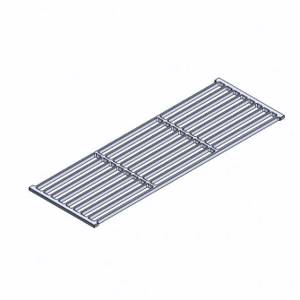
It is also necessary to take into account that if triangular rods are installed in the grate, then it must be laid with triangles down.
Recommendations
The fuel material must be completely burned, and to achieve this goal, an optimal amount of oxygen must be supplied. Therefore, the total area of the distance between the grates is no more than 60% of the total area of the grate. If the distance is smaller, a small air flow will enter the stove; this will not be enough to maintain the combustion process in the combustion chamber.
If the distance between the grates is large, the fuel material will fall without having time to burn out. This will lead to an increase in combustion consumables.
The cast iron grate for the stove provides good traction and is used for burning wood, coal and fuel briquettes. Cast iron still occupies a leading position in the manufacture of grates. Since it is least susceptible to deformation at high temperatures.
Grill installation
To make a grate for a boiler, a fixed beam structure is most often chosen. This is a composite model, based on a square or rectangle of four beams.
This square must be made according to the size of the combustion chamber in which the grate will be used. Small beams are welded into its base, and the distance between them must also be taken into account. It should be such that the material does not fall during the combustion process, and the burned residues can easily leak through these holes.
